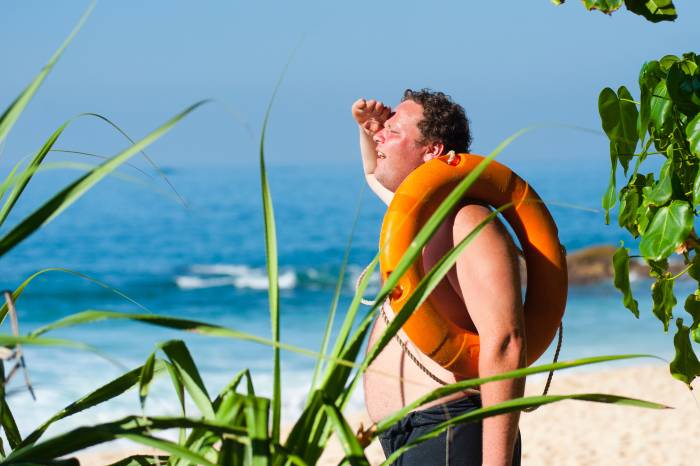Too much fun in in the sun can kill your outdoor experience – and eventually you. Here’s how to protect your skin from harmful rays.
The most painful sunburn I’ve ever had was on the roof of my mouth. Gasping for air while huffing loads up Mount Rainier, the sun’s powerful light reflected off the glacier and onto – of all places – my upper palette! I spent the rest of the trip with a blister on the roof of my mouth. I felt like I had just inhaled piping hot pizza, but without the greasy reward.
We all know better. Wear a hat, apply sunblock, wear sunglasses. It’s easy to remember in the dead of summer. But we tend to get lazy in the shoulder seasons, and a “healthy glow” isn’t all that healthy.
Keep these pointers in mind as you venture out this spring.
What Is Sunburn?
Sunburn is the skin’s inflammatory response to UVA and UVB light overexposure. UVA radiation is more common in the atmosphere and penetrates deeper into the skin than does UVB.
Accumulated UVA exposure over time is the primary cause of wrinkles and age spots. It can also scramble basal cells’ DNA, leading to skin cancer. UVB causes the superficial redness one feels after the burn and can also cause cancer.
How to Identify Sunburn
Sunburns can happen at any time, in weather ranging from ski or surf. Light reflecting off bright snow, sand, or water makes sunburn more likely. And the risk is greater at high altitude, where the atmosphere is thinner and less protective.
After mild exposure, the skin will look red and feel hot and painful. More severe sunburns can cause blisters, dizziness, fatigue, and sometimes even a low-grade fever. The pain will start to kick in four to six hours after exposure and can last up to two days.
How to Avoid Sunburn
Your best bet is to keep the sun off your skin between the hours of 10 a.m. and 4 p.m., when its rays are at their most intense. Doing the following will also help tremendously:
- Wear long-sleeved shirts and pants. Look for garments with UPF (ultraviolet protection factor) ratings, which block skin-damaging UV radiation. A UPF rating of 30 means the fabric allows 3% UV light to come through, thus blocking 97% of damaging rays.
- Wear a hat with a wide brim to keep the sun off your face and neck. People with thinning (or no) hair should also wear a hat to protect the scalp.
- Take breaks in the shade.
- Liberally apply “broad spectrum” or “multi-spectrum” sunblock (rated at least SPF 15) 15–30 minutes before going outside.
- Reapply sunblock every two hours. Sweat, clothing, water, and general absorption reduce the effectiveness of the original application.
- Be aware of medications you are taking. Some medications increase the skin’s sensitivity to the sun.
- Watch your little ones, who have more sensitive skin and higher skin surface area to body weight ratios.
- Pay particular attention to your ears, nose, and lips. All these catch rays, and sun protection can be wiped off easily.
- Don’t forget to protect your eyes. Wear sunglasses that block the harmful UVA and UVB rays.
What Does SPF Mean?
SPF (sun-protection factor) refers directly to sunscreen’s ability to block sunburn-causing UVB rays. The SPF rating correlates with how long it will take your skin to burn.
So if you tend to burn after 10 minutes, SPF 15 could imply you can stay out in the sun for 150 minutes before burning wearing that rating sunscreen (10 minutes x SPF 15 = 150 minutes before you burn). But if you typically start to burn in five minutes, you would need to apply SPF 30 to stay out in the sun for the same 150 minutes without burning (5 minutes x SPF 30 = 150 minutes).
SPF protection isn’t on a linear scale, but a logarithmic one. This means SPF 30 is not twice as effective as SPF 15. After SPF 15, which blocks 93% of UVB rays, the differences are slight: SPF 30 blocks 97% and SPF 50 blocks 98%.
Also, it’s important to understand SPF addresses only half of the picture. It’s not taking harmful UVA rays into account. So consider a “broad-spectrum” or “multi-spectrum” lotion that blocks both UVB and UVA rays.
UVA-blocking ingredients include titanium and zinc oxide.
How to Treat Sunburn
Got burned? Expect it to be painful, but know the pain will subside after a day or so. Get out of the sun and find a way to shade affected areas. To get you through the worst of it, place a cool, moist compress on the burned skin.
Ibuprofen or aspirin can reduce pain and swelling. And applying moisturizer, including aloe, may help alleviate pain. Hang in there!
Sunburn: Worst-Case Scenario
A British dermatology study in 2012 found that most people don’t apply enough sunblock, which greatly reduces its ability to protect the skin. While the pain will subside, the damage can be permanent. You could experience premature wrinkles and age spots or, worse, terminal skin cancer.
It’s important to remember the sun’s rays can cause damage any time of year. So it’s good practice to wear protection whenever you head outside. Sunscreen is essential, and it’s effective only if used correctly. One brand not working? Keep looking until you find one you can live with.
And it’s important to remember: Sometimes there is no special product – you just need to keep the sun off. And, at least for me, that means keeping your mouth closed!



